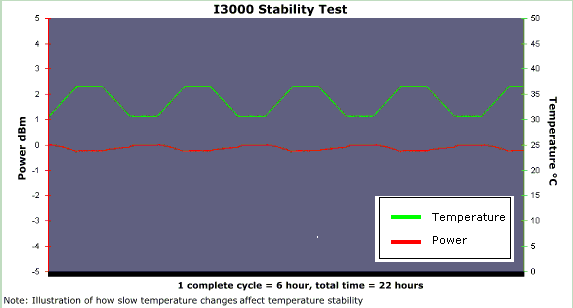Overview
The following tests characterize the thermal stability of the Luminos I3000 CORALIGN™ Positioners. By optimizing the unit and subjecting it to a series of thermal cycles it is possible to plot the drift characteristics.
Equipment Used
-
Temperature-control chamber (±1°C)
-
I3000 manual positioner
-
1300nm LED source
-
Power meter
-
Two fibers with connectors on both sides
-
Ferrule fiber holder
-
Connector holder
-
Anti-resonance platforms
Procedure

To ensure that only temperature stability was being measured an anti-resonance platform was constructed. Stability tests were conducted with a connector-to-connector, 9µm core, single mode fiber alignment. Positioner, power meter, and light source were arranged, as shown, on anti-resonance platform. The platform was then place inside the chamber and allowed to acclimate to a temperature of 30°C. Once the positioner was acclimated the unit was optimized and test started. Temperature and power samples were automatically collected every two minutes for three days.
Test 1 - Gradual Temperature Change
This test illustrates how gradual temperature fluctuations affect the Positioners stability. Test result, as demonstrated in the graphic below, show a maximum -0.25dBm variations when temperature is slowly increased to 36°C. Every time the temperature cycles back to the initial set point of 30°C, power returns to the reference power reading ±0.005dBm.

Test 2 - Sudden Temperature Change
Stability test two illustrates how sudden temperature fluctuations affect the stability of the I3000 manual positioners. The results, shown below, demonstrate that a sudden power fluctuations of -0.3 to -4 dBm when temperature is ramped. When unit was subjected to a temperature changed of +6°C from the initial start point of 30°C, a variance of less than 0.4dBm was evident after unit stabilized. After one cycle was completed and temperature returned to 30°C power variations were not evident.

Conclusion
Tests prove that the I3000 manual positioner has virtually no hysteresis due to temperature changes. Output variations are cyclic and repeatable and there are no lasting distortions on the positioner due to temperature fluctuations. Therefore temperature changes have a predictable cyclic effect on the stability of the Luminos I3000 CORALIGN™ Positioner.
